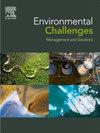采用再生塑料片和火山灰添加剂的HVFAC的微观结构和力学评价
Q2 Environmental Science
引用次数: 0
摘要
本研究考察了大体积粉煤灰混凝土(HVFAC)在塑性和硬化状态下的微观结构行为,强调了成分材料如何影响性能特征。由于微观结构决定了机械强度、耐久性和长期稳定性,因此本研究评估了外加剂对结构完整性的影响。它强调混合设计修改,以定制微结构特性,并通过工程材料组合提高混凝土性能。在8天的时间里,用不同比例的普通波特兰水泥(OPC)、Pozzo Crete 100(处理过的粉煤灰)、硅粉(SF)和废塑料瓶片(pbf)开发了11种M-30级混凝土混合物,胶凝材料的减水剂重量为1%。水固化28天后,进行抗压强度和无损检测(NDT)评估力学性能。通过扫描电子显微镜(SEM)和能量色散x射线能谱仪(EDS)对每种混合物的粉末样品进行微观结构分析。研究揭示了不同的形态特征,包括密集,精炼的矩阵;多孔界面过渡区(ITZ);球形粉煤灰颗粒;玻璃材质;部分未反应的火山灰物质。致密的微观结构与更高的耐久性相关,包括降低渗透性,增强抗氯化物侵入和化学侵蚀能力,表明适合腐蚀性环境。此外,包括塑料废物支持可持续发展目标,并提供了潜在的非结构或中等负荷应用,平衡机械性能与环境考虑。本研究强调了协同材料组合的潜力,以优化混凝土的目标性能和可持续性结果。本文章由计算机程序翻译,如有差异,请以英文原文为准。

Microstructural and mechanical evaluation of HVFAC incorporating recycled plastic flakes and pozzolanic additives for environmental sustainability
This research examines the microstructural behaviour of High-Volume Fly Ash Concrete (HVFAC) in both plastic and hardened states, highlighting how constituent materials influence performance characteristics. As microstructure governs mechanical strength, durability, and long-term stability, the study evaluates the impact of admixtures on structural integrity. It emphasizes mix design modifications to tailor microstructural properties and enhances concrete performance through engineered material combinations. Eleven M-30 grade concrete mixes were developed over eight days using Ordinary Portland Cement (OPC), Pozzo Crete 100 (processed fly ash), Silica Fume (SF), and Waste Plastic Bottle Flakes (PBFs) in varying ratios, with 1 % superplasticizer by weight of cementitious material. After 28 days of water curing, compressive strength and non-destructive testing (NDT) assessed mechanical performance. Microstructural analysis via Scanning Electron Microscopy (SEM) and Energy-Dispersive X-ray Spectroscopy (EDS) was performed on powdered samples from each mix. The studies revealed diverse morphological features, including dense, refined matrices; porous Interfacial Transition Zones (ITZ); spherical fly ash particles; glassy textures; and partially unreacted pozzolanic materials. A denser microstructure correlated with improved durability, including reduced permeability and enhanced resistance to chloride ingress and chemical attack, suggesting suitability for aggressive environments. Additionally, including plastic waste supports sustainability goals and presents potential for non-structural or moderately loaded applications, balancing mechanical performance with environmental considerations. This study highlights the potential of synergistic material combinations to optimize concrete for targeted performance and sustainability outcomes.
求助全文
通过发布文献求助,成功后即可免费获取论文全文。
去求助
来源期刊

Environmental Challenges
Environmental Science-Environmental Engineering
CiteScore
8.00
自引率
0.00%
发文量
249
审稿时长
8 weeks
 求助内容:
求助内容: 应助结果提醒方式:
应助结果提醒方式:


